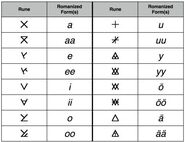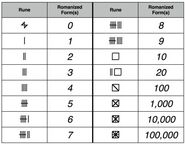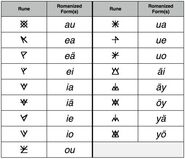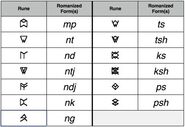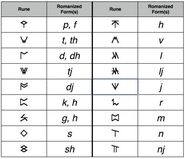(→Cases) |
|||
| Line 57: | Line 57: | ||
(Singular/Plural) |
(Singular/Plural) |
||
| − | * Nominative – -il |
+ | * Nominative: – -il |
| − | * Accusative -e -ile |
+ | * Accusative: -e -ile |
| − | * Dative -a -ila |
+ | * Dative: -a -ila |
| − | * Genitive -as -asil |
+ | * Genitive: -as -asil |
| − | * Comitative -ath -athil |
+ | * Comitative: -ath -athil |
| − | * Instrumental -ar -aril |
+ | * Instrumental: -ar -aril |
| − | * Adessive -asku -ilasku |
+ | * Adessive: -asku -ilasku |
| − | * Ablative -aske -ilaske |
+ | * Ablative: -aske -ilaske |
| − | * Allative -aska -ilaska |
+ | * Allative: -aska -ilaska |
| − | * Inessive -aslu -ilaslu |
+ | * Inessive: -aslu -ilaslu |
| − | * Illative -asla -ilasla |
+ | * Illative: -asla -ilasla |
| − | * Elative -asle -ilasle |
+ | * Elative: -asle -ilasle |
| − | * Essive -eshe -eshel |
+ | * Essive: -eshe -eshel |
| − | * Translative -efe -efil |
+ | * Translative: -efe -efil |
| − | * Benefactive -eva -evel |
+ | * Benefactive: -eva -evel |
The word order of Shiväisith is always SVO (i.e. subject, verb, object). Therefore, other things have to change in order to accommodate this. Take for example: |
The word order of Shiväisith is always SVO (i.e. subject, verb, object). Therefore, other things have to change in order to accommodate this. Take for example: |
||
Revision as of 18:51, 12 March 2018
Shiväisith[1] is the native language of the Dark Elves. While the Dark Elves can speak other languages, it is their native tongue and the language they prefer to use to converse among themselves[2]. It is written in a system of runes called Todjydheenil[1] (see Gallery).
History
| This section needs a rewrite |
The speakers of Shiväisith, the Dark Elves, have existed since before the dawn of the Universe[2], and their language has been spoken throughout their history and throughout the eons has evolved like any natural language[1]. Although they are capable of speaking in other languages, as seen when communicating with Asgardians and Humans, the Dark Elves primarily converse in this language among themselves. It is spoken by Malekith and Algrim while planning their attacks on Asgard's forces during the First Dark Elf Conflict in the distant past as well as during the Second Dark Elf Conflict in present day.[2]
Shiväisith is one variant of the Elvish language, with other species of Elves speaking other languages or dialects that may be related to each other and to Shiväisith[1]. The Dark Elves' language is called the “soft speech” because it is characterized by a frication rule which softens "hard" sounds like p, t, d, k, and g into "soft" sounds like f, th, dh, and h (see Phonology)[1].
Phonology
The phonology for Shiväisith is mostly similar to Finnish, notably its use of the same vowel harmony system[1].
Vowels
As per vowel harmony, you can only ever have vowels from one of these two sets in a word:
- Standard Grade: a, e, i, o, u (short); aa, ee, ii, oo, uu (long)
- Fronted Grade: ä [æ], e, i, ö [ø], y (short); ää, ee, ii, öö, yy (long)
Consonants
Notable consonants in Shiväisith not present in English are dj [ɟ] and tj [c][1].
Phonemic "h" disappeared from in between vowels, an occurrence that developed in the language's history before spirantization did[1].
The "Soft Speech"
Shiväisith has an intervocalic spirantization rule[1]. The stops p, t, d, k and g become f, th [θ], dh [ð], h and h, respectively, in between two vowels, at the end of a word, between an approximant and vowel, and in between a liquid and a vowel, but not in between a vowel and then a liquid[1].
Shiväisith is called the “soft speech” because it is characterized by this rule which affects all stops. The name comes from the impression of the language, which sounds “softer” because all the stops have been turned to fricatives in most situations. Some examples are:
- *lakip > lahif prison
- *ääpit > ääfith arrival
- *yyd > yydh wave
- *rutiki > ruthihi to feel
You can see some of these at work. For example, the word for “prison”, lahif, has a reappearing k in its associated verb, i.e. in the imperfective~perfective stem pairing:
- lah- ~ lakka- to capture
You can also see the old stops reappearing in some other places. For example, compare these two words:
- tif thing
- tiplju what
Consonant Harmony
In addition to vowel harmony, Shiväisith has sibilant harmony, a kind of consonant harmony, which means the sibilants must agree in a word[1]. Thus, if a word has an s in it, it will only have s’s; never sh [ʃ]—and vice versa. As an example, here are some nominative-genitive pairs:
- säli~säliäs - cave
- päsh~päshäsh - stone
- näinä~näinäs - state
If the word is a compound, the harmony doesn’t jump the break[1], for example in Shiväisith (shive means “soft” and äisith is “speech”).
Grammar
Shiväisith has a large number of grammatical cases, which reflect the grammatical function performed by a word in a phrase, and is always head-final (SVO word order)[1].
Cases
Grammatical cases are not a main feature in English but they appear in other languages such as Finnish. An example from English would be pronouns and their subjective case (I, you, he, she, it, we, they, who, whoever), objective case (me, you, him, her, it, us, them, whom, whomever) and possessive case (my, mine; your, yours; his; her, hers; its; our, ours; their, theirs; whose; whosever). The cases in Shiväisith are[1]:
- Grammatical: Nominative, Accusative, Dative
- Relational: Genitive, Comitative, Instrumental
- Exterior: Adessive, Allative, Ablative
- Interior: Inessive, Illative, Elative
- Equative: Essive, Translative, Benefactive
To decline a word, a suffix is added according to the table below[3]:
(Singular/Plural)
- Nominative: – -il
- Accusative: -e -ile
- Dative: -a -ila
- Genitive: -as -asil
- Comitative: -ath -athil
- Instrumental: -ar -aril
- Adessive: -asku -ilasku
- Ablative: -aske -ilaske
- Allative: -aska -ilaska
- Inessive: -aslu -ilaslu
- Illative: -asla -ilasla
- Elative: -asle -ilasle
- Essive: -eshe -eshel
- Translative: -efe -efil
- Benefactive: -eva -evel
The word order of Shiväisith is always SVO (i.e. subject, verb, object). Therefore, other things have to change in order to accommodate this. Take for example:
- Kir dahar nole. “I curse you.”
A verb like dahihi "curse" is an ordinary transitive verb, which takes an ordinary case frame. This means that its subject will take the nominative case, and its object the accusative case. The nominative case for kir, the first person singular pronoun (“I”), is the bare form of the word. The accusative case of nol, the second person singular pronoun (“you”), takes the accusative case, which in this case is realized by suffixing an -e to the stem, giving you nole. Additionally, the verb agrees with the subject in person and number, so the stem dah- takes the suffix -ar, which agrees with kir.[1]
Another example is:
- Kira liljal nol. “I love you.”
A verb like liljahi "love" works differently. Verbs of this type (called experiencer verbs) take a different case frame in Shiväisith. First, the verb now agrees with the object, which takes the nominative rather than the accusative case. Thus nol is unmodified, and the stem lilj- takes the -al suffix. The subject of the sentence, rather than taking the nominative case, takes the dative case, which in this case is realized by suffixing an -a to the stem, giving you kira.[1]
There are a couple of verbs of Shiväisith that work like liljahi[1]. One is öppihi, which means “to hurt” or “to feel pain”. Here’s an example:
- Kira öppith motja. "My leg hurts." (literally, "My leg hurts me")
Motja there is in the nominative.
Another is ruthihi "to feel"[1], example below:
- Kira ruthith äshlime. "I feel the warmth.“
There again, äshlime, "warmth" is in the nominative.
More examples to illustrate the distinction clearly[1]:
- Kira ruthith äshlime. "I feel the warmth.”
- Äshlimä ruthar kir. "The warmth feels me.“
- Kira öppith motja. "My leg hurts.”
- Motja öppär kir. "The leg’s me hurts.“ (as in roughly, "I hurt the leg")
Verbs
Stems system
Verbs have two forms/stems, their short form and long form[1]:
- vur (short)
- vuuri (long)
These forms can be used on their own (plus personal endings), or they can have other suffixes added to them, and function as an imperfect vs. perfect system[1]. The base form was taken to be the imperfect form (an action that’s being viewed as ongoing), and the derived form is the perfect form (a completed action)[1]. The perfect form is derived by making a disyllabic stem with a long consonant or vowel from the original imperfect stem[1]. Some examples include:
- vur- ~ vuuri- "see"
- hööth- ~ hötte- "breathe"
- poha- ~ pooha- "call"
- deinä- ~ dennä- "burn"
Long stem
To derive the long stem from the root, first determine if the root ends in a vowel or a consonant.
If the root ends in a vowel and the first vowel of the root is short, simply lengthen the vowel for the long stem. Examples:
- poha- “call out” > pooha-
- upsi- “need” > uupsi-
If the first vowel of the root is long or a diphthong, you double the consonant before the final vowel and shorten the first vowel of the root. Examples:
- deinä- “burn” > dennä-
- uatha- “remember” > utta-
If the root ends in a consonant and the first vowel of the root is short, lengthen the vowel and add i to the end if the lengthened vowel is high (i.e. i, y or u), or e to the end if the lengthened vowel is non-high (i.e. o, ö, e, a or ä). Examples:
- ruth- “feel” > ruuthi-
- mor- “finish” > moore-
If the first vowel of the root is long or a diphthong, you double the final consonant and shorten the first vowel of the root. Then you add i to the end if the shortened vowel is high (i.e. i, y or u), or e to the end if the shortened vowel is non-high (i.e. o, ö, e, a or ä). Examples:
- kiam- “play” > kimmi-
- hööth- “breathe” > hötte-
Additional Inflection
The first additional change can be a particle (probably descended from an old adverb) that places the action in the past[1]:
- vuran - was seeing (incomplete action in the past)
- vuurin - saw (complete action in the past)
Therefore, the two previous examples are unmarked tenses:
- vur - sees/is seeing (incomplete action in the present)
- vuuri - saw (complete action in the present)
To distinguish a completed action in the present from a completed action in the past, (native) speakers use the hodiernal interpretation, or a completed action with present relevance.[1]
The other tenses work in the same way: a second past producing habitual and ancient actions and subjunctives. The future and conditional forms were created at an even later date, with pre-verbal auxiliaries taking the place of the old post-verbal particles.[1]
Questions
Yes/No Questions
Like in English, the change from a statement to a yes/no question is simply the tone, or, orthographically, a question mark[1]:
- Passajamanal onola. - You have prepared yourself.
- Passajamanal onola? - Have you prepared yourself?
"WH" Questions
Rouklju is “who” in the nominative (since “who” is the subject of the sentence); the verb is roosenith, which ends in -ith because the subject is third person singular, and “prisoner” is lahifiksa, which, since it’s the object of the sentence, is in the accusative case, meaning the final a becomes e[1]:
- Rouklju roosenith lahifikse? - Who killed the prisoner?
To ask about who got killed, the word order doesn’t change at all, but the cases do. In WH-questions [who, what, where, why, etc.], the verb always comes second, and the question word always comes first. After that, you list whatever’s left in its usual order. That means, in this case, the subject comes last[1]:
- Rouhelju roosenith lahifiksa? - Whom did the prisoner kill?
There are certain instances where a verb takes an auxiliary (i.e. the future and the negative form of all tenses). The following example is in the future tense, and the order ends up being identical to English[1]:
- Rouhelju äth lahifiksa rosihi? - Whom will the prisoner kill?
In the case of the adverbial WH-words, you’ll have to put each one in a case based on its role in the sentence. The question word igreljy, “where”, is put into the adessive case, becoming igräskyljy[1]:
- Igräskyljy roosenith geilää lahifikse? - Where did the warrior kill the prisoner?
To ask “how many”, you use visiljy followed by whatever you’re talking about in the genitive plural. You can omit it and just say “how many”. The subject is visiljy, which is always singular, so the verb continues to take third person singular subject agreement despite the fact that we’re talking about (potentially) multiple warriors[1]:
- Visiljy geilääsil roosenith lahifikse? - How many warriors killed the prisoner?
- Visiljy roosenith lahifikse? - How many killed the prisoner?
You can also take -lju/-ljy and attach it to nouns ask “which noun”[1]:
- Geilääljy roosenith lahifikse? - Which warrior killed the prisoner?
- Geileeljy roosenith lahifiksa? - Which warrior did the prisoner kill?
Words
Words of Interest
- Shiväisith-soft speech
- Todjydheen-rune (plural todjydheenil)
- Älfenää-blue-purple one, Dark Elf (plural Älfeneel)
- Harudheen-The Great Home, Svartalfheim / the Dark World (the Dark Elf home world)
- Harudheeniksa-resident of Haudheen
- Mälekith-Malekith, leader of the Dark Elves
- Älgrim-Algrim, Malekith's lieutenant
- Äskärdh-Asgard
- Äskärdhiksä-resident of Asgard, Asgardian (plural Äskärdhiksel)
- Kevethidheen-the Convergence
- Äither-the Aether
- Lenger-Human
- Rashidheen-the Universe
Dictionary
The list of known words alphabetized by their transcription into the Latin script. Shiväisith is a highly inflected language, therefore the verbs are presented alongside their short and long stems, respectively, and the nouns in their nominative, accusative, dative, and plural forms, respectively, when known, otherwise place held with a question mark (?).
(v.) - full, short, long
(n.) - nominative, accusative, dative, plural
- ääfith (n.) arrival
- ahi, a-, ää- (v.) to be
- äisihi (v.) to speak
- äisith (n.) speech
- äither (n.) ether
- ajafihi, ?, ? (v.) to become
- äpähi, äpä-, äppä- (v.) to come
- äshli (adj.) warm
- Äshlimär hello
- äshlime, ?, äshlimä, ? (n.) warmth
- Äskärdh Asgard
- Äskärdhiksä, ?, ?, Äskärdhiksel (n.) Asgardian
- athu (n.) friend
- dääth (n.) wind
- dahihi, dah-, daahe- (v.) to curse
- deinähi, deinä-, dennä- (v.) to burn
- dihi (adv.) well
- djesh (n.) door
- djohi, djo-, djoo- (v.) to go
- djoss (n.) pit
- domohi, domo-, doomo- (v.) to watch
- eeju (adj.) quiet
- erin (n.) tree
- erve (n.) poison
- ervesihi, ervesi-, ervesii- (v.) to poison
- ether (n.) ether
- geilää, geilee, Ø, ? (n.) warrior
- geilihi (v.) to fight
- gil (n.) boat, ship
- gjölf (n.) world
- gorjahi, gorja-, goorja- (v.) to die
- gorjeth, -e, -a, ? (n.) death
- gov, -e, -a, ? (n.) blood
- gyv (adj.) big, large
- hanlju why (hanaskelju [ablative])
- heedrä (n.) power, might
- hööthihi, hööth-, hötte- (v.) to breathe
- huthihi (v.) to lack
- igreljy where (igräskyljy [adessive], igräslyljy [inessive], igräskäljy [allative], igräskeljy [ablative])
- iotsi, ?, ?, iotsil (n.) bird
- itri (n.) roof
- itri (n.) roof
- jääridheen (n.) way of life
- jäärljy how (jäärärljy [instrumental])
- jen (pron.) us
- jöh (n.) knife
- jov (n.) woman
- ju (conj.) or
- juli (adj.) new
- käthi (adj.) good
- kelihi (v.) to win
- kevethidheen (n.) convergence
- kiamihi, kiam-, kimmi- (v.) to play
- kir (pron.) I
- koun, -e, -a, -il (n.) shore
- köyf, -e (n.) air
- lahi, lah-, lakka- (v.) to capture
- lahif (n.) prison
- lahifiksa (n.) prisoner
- läin, ?, ?, -il (n.) child
- lenge (n.) meat
- lenger, ?, ?, -il (n.) human
- lihi, li-, y- (v.) negative verb
- liljahaa (n.) lover
- liljahi, lilja-, liilja- (v.) to love (experiencer)
- liljeth, -e, -a, ? (n.) love
- livihi, livi-, liivi- (v.) to attack
- ljääl (conj.) please
- lorahaa (n.) flyer
- lorahi, lora-, loora- (v.) to fly
- loreth, -e, -a, ? (n.) flight
- luun, -e, -a, ? (n.) nose
- mänih (adj.) previous, former
- mavihi, mav-, mavv- (v.) to send
- moodhin (adj.) close, near
- morihi, mor-, moore- (v.) to finish
- motja, ? , Ø, ? (n.) leg
- mouhe (n.) enemy
- näinä (n.) state (näinäs [genitive])
- Näkäthish goodbye
- niämi (n.) mother
- nishö (n.) reflection
- nol (pron.) you
- nöön (pron.) you all
- nyrihi (v.) to sleep
- öppihi, öppi-, ? (v.) to hurt (dative subject)
- ötjä (pron.) that
- päsh (n.) stone (päshäsh [genitive])
- passajamanasos (adj.) prepared
- pausahi, pausa-, passa- (v.) to settle
- pausajamihi, pausajam-, passajam- (v.) to prepare, to make ready, to cause settle
- pel (adj.) certain, sure
- pohahi, poha-, pooha- (v.) to call out
- pökke (n.) house
- rashidheen (n.) universe
- reev (n.) sun
- rosihi, ros-, roos- (v.) to kill
- rosith (n.) killing
- rouklju who (rouhelju [accusative], rouhalju [dative], rouhaslju [genitive—i.e. “whose”])
- ruthihi, ruth-, ruuthi- (v.) to feel (experiencer)
- Ruushuudhith thank you (Ruushuudhith nöönäsky [plural])
- Sääriljy when (sääriäskyljy [adessive], sääriäskäljy [allative], sääriäskeljy [ablative])
- säli (n.) cave (säliäs [genitive])
- shaan (adj.) white
- shive (adj.) soft (as in "not hard")
- taam (adj.) tight
- tash, -e, -a, -el (n.) word
- teitjö, teitje ,?, teitjyl (n.) song
- tif (n.) thing
- Tifevadhoh you’re welcome
- tiplju what (tifelju [accusative], tifalju [dative]) ["what" is essentially "thing" tif with a suffix]
- tjäsh (conj.) no
- toom (n.) weapon
- tor, -e, -a, ? (n.) sword
- tove, Ø, tova, tovil (n.) moon
- tukka, tukke, Ø, tukkel (n.) sheep
- uathahi, uatha-, utta- (v.) to remember
- uli, -e, -a, -l (n.) berry
- upsihi, upsi-, uupsi- (v.) to need
- uuris (n.) star
- vään (pron.) they
- vääth (conj.) yes
- van (n.) man
- vath (pron.) he/ she / it
- velemefe, Ø, velemefa?, ? (n.) darkness
- visiljy how many (visieljy [accusative], visiäljy [dative])
- vörth, -e,-a, ? (n.) king
- vurihi, vur-, vuur- (v.) to see
- yrihi (v.) to jump
- yydh (n.) wave
Pronouns
Independent:
- I - Kir
- you - Nol
- he/she/it - Vath
- we - Jen
- you all - Nöön
- them - Vään
Reflexive:
- myself - öör
- yourself - onol
- himself/herself/itself - ovath
- ourselves - öjen
- yourselves - önöön
- themselves - övään
Numbers
Cardinal numbers (one, two, three) / ordinal numbers (first, second, third)
zero: tifidhoh (nothing)
- heth / kyäthis
- kör / köös
- mitta / mittas
- kitta / kittas
- pesh / peshish
- täni / tänis
- gah / gakkis
- dulin / dulis
- djyyr / djyysh
- jav / javis
- javeth / javethis
- jav kör / jav köös
- jav mitta / jav mittas
- jav kitta / jav kittas
- jav pesh / jav peshish
- jav täni / jav tänis
- jav gah / jav gakkis
- jav dulin / jav dulis
- jav djyyr / jav djyysh
- körjev / körjevis
- körjev heth / körjev kyäthis
30: mitjev / mitjevish
40: kitjev / kitjevish
50: peshev / peshevish
60: tänjev / tänjevis
70: gakjev / gakjevis
80: duljev / duljevis
90: djyyrjev / djyyrjevish
100: vysh / vyshish
1,000: teem / teemis
10,000: jav teem / jav teemis
100,000: teemidheen / teemidheenis
Phrases
- Kira liljal nol. - I love you.
- Kir dahar nole. - I curse you.
- Geilää liivinith vathe jöhär. - The warrior attacked him with a knife.
- Vään domonavil djossasle. - They were watching from a pit.
- Nöönä äth ruthihi veleme. - You all will feel the darkness.
- Äskärdhiksel livil nyrihi. - The Asgardians aren’t sleeping.
- Lengeril mavvavil läinilevii mouhela. - The humans sent their children to the enemies earlier today
- Vath äth mänih vanki. - He is my former husband.
- Jen hööthäjel köyfe käntjeriäshlä. - We always breathe air.
- Kir ervesiinär govave. - I poisoned his blood.
- Passajamanal onola. - You have prepared yourself.
- Passajamanal onola? - Have you prepared yourself?
- Rouklju roosenith lahifikse? - Who killed the prisoner?
- Rouhelju roosenith lahifiksa? - Whom did the prisoner kill?
- Rouhelju äth lahifiksa rosihi? - Whom will the prisoner kill?
- Igräskyljy roosenith geilää lahifikse? - Where did the warrior kill the prisoner?
- Visiljy geilääsil roosenith lahifikse? - How many warriors killed the prisoner?
- Visiljy roosenith lahifikse? - How many killed the prisoner?
- Geilääljy roosenith lahifikse? - Which warrior killed the prisoner?
- Geileeljy roosenith lahifiksa? - Which warrior did the prisoner kill?
Speakers
Gallery
Behind the Scenes
- There were originally many more scenes with Malekith and Algrim in which they spoke in Shiväisith as well as expanded on their background and culture, but they were later cut.[1]
- Shiväisith language was created by linguist David J. Peterson, who was commissioned to create a language for the Dark Elves after his work on the Dothraki language for the television show Game of Thrones, and introduced in Thor: The Dark World.
- Shiväisith was Finno-Ugric inspired and Todjydheenil was inspired by Nordic runes. Given that the Asgardians were based on Norse mythology, thus North Germanic, the "other" should be Finnish, thus Finno-Ugric. Therefore, the Dark Elves' language is reminiscent of Finnish, just as the Asgardian names are all reminiscent of Scandinavian.[1]
- Peterson suggests Shiväisith would be appropriate for a long-form epic or saga, such as an epic about the Dark Elves using the original sources from the comics, although he laments it will probably be never done, mainly because it requires an enormous amount of time and effort both on the part of the creators of the language and the lore.[1]
- Learn more about this language at: https://shivaisith.wordpress.com/author/shivaisith/ and at http://fuckyeahshivaisith.tumblr.com/
- Follow David J. Peterson directly at https://dedalvs.tumblr.com/

